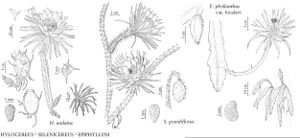Hylocereus
Contr. U.S. Natl. Herb. 12: 428. 1909.
| Taxon | Illustrator ⠉ | |
|---|---|---|
 | Hylocereus undatus Selenicereus grandiflorus Epiphyllum phyllanthus var. hookeri | John Myers John Myers John Myers |
Shrubs, epiphytic, hemiepiphytic, or epipetric, straggling, climbing, scandent, or pendent, irregularly many branched. Roots diffuse, often adventitious along stem internodes. Stems segmented, green, blue-green, gray-green, or somewhat whitish with wax; segments elongate, 3-winged or angled, length highly variable, 10–500+ × [1–] 4–7.5 [–10] cm, distinctly narrowed proximally, glabrous; ribs (2–) 3 (–5), winglike to narrowly triangular in cross-section, rib crests straight to undulate, crenate [toothed, notched, or lobed], often with a line of hard, brown to gray bark between areoles; areoles (10–) 35–50 mm apart along ribs, oval, short woolly, sometimes subtended by minute, vestigial leaves at growing stem tip; areolar glands inconspicuous; cortex and pith mucilaginous. Spines 0–4 [–8] per areole, whitish or yellowish to brownish [blackish or red, aging gray], acicular [awl-shaped or hairlike], straight, terete, generally short, 0–4 [–10] mm, hard, bases sometimes conic or swollen, smooth, glabrous; radial and central spines not distinguishable. Flowers nocturnal, lateral to subterminal on 1+-year-old stems, at adaxial edges of areoles, long tubed, funnelform, [3–] 25–29 [–38] × [8–] 15–25 [–30] cm; outermost tepals often greenish, yellow, pink, or occasionally purplish red or white, 10–15 × 1–1.5 cm, margins entire; inner tepals white to cream [rarely pinkish or red], 10–15 × 1.5–2.5 cm, margins entire; ovary tuberculate [to smooth], scaly, spineless, usually without hairs or wool; scales triangular, broad, thick conspicuous, to 25 mm; stigma lobes to 24, white. Fruits irregularly dehiscent along 1 side, red [to purple or magenta], oblong to ovoid or spheric, [20–] 50–125 × 40–120 mm, fleshy, spineless; pulp white; scales persistent, green, triangular, conspicuous, thick and fleshy, to 4+ cm; floral remnant often persistent. Seeds black, [elongate or] pyriform [to reniform], 2–3 mm, glossy; testa smooth or minutely textured. x = 11.
Distribution
Introduced; subtropical and tropical regions of Mexico, West Indies, Central America, n South America
Discussion
Species 18 (1 in the flora).
Selected References
None.
Lower Taxa
"thick" is not a number. "thick" is not a number. "broad" is not a number.